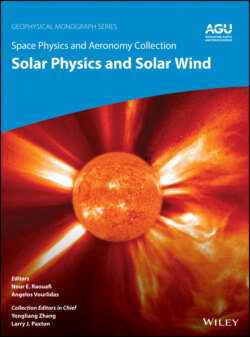Читать книгу Space Physics and Aeronomy, Solar Physics and Solar Wind - Группа авторов - Страница 23
1.4.3. Solar Wind Fluctuations at Kinetic Scales
ОглавлениеWe now discuss the turbulent fluctuations at the end of the Kolmogorov inertial range and at smaller scales, that is, the kinetic range of the solar wind turbulence, sometimes called the dissipation range by analogy with the usual hydrodynamic (HD) turbulence.
Approaching ion scales (100 km at 1 AU), the MHD approximation is no more valid, and ions and electrons cannot be considered as one fluid. As protons are much heavier than electrons, in the vicinity of the ion inertial length λi , there is a separation into two fluids (Hall‐MHD description). Arriving at the ion Larmor radius scale, ρi , ions should be considered as particles and not a fluid. The corresponding time scale is the ion cyclotron frequency fci . In the vicinity of fci , Alfvén waves become dispersive. In plasma with anisotropic ions, the Alfvén ion cyclotron (AIC) instability generates quasi‐parallel AIC waves, visible in turbulent spectra as bumps or breaks at the vicinity of fci (e.g., L. K. Jian et al., 2014; Lion et al., 2016). The intermittent structures present in the inertial range, have their smallest spatial scales with the strongest gradients. For example, the thickness of the current sheets is observed to be several λi , or the cross section of magnetic vortices is about a few ρi (Perrone et al., 2016, 2017). These small‐scale discontinuities have a distinct Fourier spectrum, f −2, for current sheets and shocks, and f −4 for magnetic vortices (Alexandrova, 2008). Thus, the presence of different phenomena, like ion temperature instabilities (Bale et al., 2009; Hellinger et al., 2006) and the strongest gradients of the intermittent structures, is at the origin of the spectral variability observed in the frequency range covering ion scales∼[0.1,3] Hz (C. W. Smith et al., 2006).
Between ion and electron scales, ∼[3, 30] Hz at 1 AU, one observes another general power‐law behavior of the magnetic spectrum (Alexandrova et al., 2009, 2012; Sahraoui et al., 2013). This suggests a small‐scale turbulent cascade of the electron fluid (e.g., Alexandrova et al., 2008; Schekochihin et al., 2009). This cascade is more compressible than the MHD inertial range (Alexandrova et al., 2008; Hamilton et al., 2008; Kiyani et al., 2013; Leamon et al., 1998; C. S. Salem et al., 2012; Turner et al., 2011). The observed compressibility can be explained by the β ‐dependent compressibility of oblique kinetic Alfvén waves (KAWs; Cerri et al., 2017; Lacombe et al., 2017; C. S. Salem et al., 2012).
In the vicinity of the electron scales (1 km at 1 AU), ions are fully kinetic and electrons start to become kinetic, so no magneto‐fluid motions are expected anymore. At these scales, the magnetic spectrum has an exponential shape similar to the dissipation range spectrum of the usual HD turbulence; see Figure 1.1 (right). This spectrum can be explained by the dissipation of KAWs via Landau damping (Howes et al., 2006, 2011; Schreiner & Saur, 2017).
In fact, the statistical properties described above, such as spectral shape and compressibility, are just averaged characteristics of the turbulent flow. The nature of turbulence at kinetic scales remains an open question. Even if KAWs can explain the observed compressibility and the exponential spectral shape, it is not clear if turbulence at these small scales is a mixture of such linear waves. To address the question of the nature of turbulent fluctuations, one should consider time‐domain measurements and not only spectral properties. Few observations at sub‐ion scales show the presence of intermittent coherent structures in the form of current sheets (Greco et al., 2016; Perri et al., 2012) and magnetic vortices (Jovanic et al., 2020 submitted). These observations suggest a non‐homogeneous dissipation of the electromagnetic turbulent cascade in space that contradicts the homogeneous dissipation of KAWs via Landau damping.
It is possible that both phenomena, that is, a mixture of quasi‐linear waves and coherent structures, coexist within the kinetic range of scales. This can be at the origin of a balance between linear and nonlinear effects (the so‐called critical balance). To verify this point, one needs to find a way to estimate characteristic times at different scales of the kinetic range.
